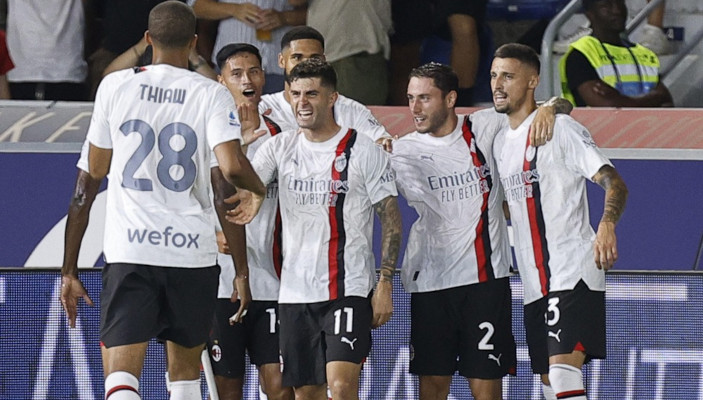The unpopular decisions to part with Paolo Maldini and sell asset Sandro Tonali proved critical as Milan pulled out a successful summer revamp, writes Matt Santangelo.
Days after bidding farewell to fabled star Zlatan Ibrahimović, owner Gerry Cardinale cracked the whip and revealed his intention to make wholesale changes to Milan, no matter how unpopular they may be. The first bombshell move to take place was the sudden dismissal of club legend Paolo Maldini from his directorial role, with Frederic Massara honourably choosing to step down himself.
Undoubtedly, the Italian’s exit sent shockwaves around Milano, Italy and wider world football, for the Maldini namesake warrants no further explanation as it is synonymous with the Rossoneri’s successes spanning more than a half-century.
Then it was the courtship and swift coup of Sandro Tonali by the ambitious Newcastle United who made it abundantly clear that, after failing in their attempt to lure Nicoló Barella from Inter, they set out to make a statement in their long-awaited return to the UEFA Champions League.
In a matter of a few weeks, Milan had suddenly begun to lose not only its identity but the trust of their supporters. Dismissing Maldini and selling Tonali to the highest bidder are two actions that can only be described as reckless considering the timing during the club’s recent resurgence.
However, Cardinale’s rash decision-making and ruthless approach towards further revolutionizing the project sparked a summer in which Milan underwent the necessary changes towards elevating the sporting project to new heights.
Cardinale’s appointment of Giorgio Furlani as CEO (from the previous December) and Geoffrey Moncada’s promotion into a more influential role on the market surprised many as the two worked diligently to bolster a squad in dire need of a facelift. In the centre of the pitch, three key new signings were made: Tijjani Reijnders, Yunus Musah and Ruben Loftus-Cheek.
The Dutch international may not have been a known commodity across Europe, but with Xavi and Barcelona keen on him, it does lend some credibility to his name and quality as a midfielder who can offer quite a bit in various roles.
Reijnders’ passing range and progressive play style showed themselves at AZ Alkmaar, and they now make him a versatile, plug-and-play option to Stefano Pioli throughout the campaign.
Meanwhile, the English veteran Loftus-Cheek had been on the radar for months while Maldini and Massara were in charge of the market. With the framework for a deal having already been established, it did not come as much surprise to see Loftus-Cheek find his way over to Milano.
Chelsea needed to offload him as part of their own rebuild under Mauricio Pochettino and it was understood Furlani could corral the England international’s signature on favourable terms. The same could be said about Christian Pulisic, a highly gifted and marketable attacking piece that Milan were deficient in.
The American’s ability to dribble, weave around in the attacking third and create have been apparent for years now, in addition to his likability and commercial appeal to the American market Cardinale has so obviously aimed to tap into.
Provided he stays fit and available for selection, this is a move surely to make an impact – on the pitch and off. In addition to Pulisic, the double swoop of Samuel Chukwueze and Noah Okafor for a combined fee of around €40m sees the attack reinforced significantly with players who can move the needle.
Both the Nigerian and Swiss had 12 months remaining on their existing contracts, making deals with Villarreal and RB Salzburg feasible in a market ballooning by the week. Milan have added an explosive right winger in Chukwueze and a flexible forward with Okafor who can shift around the attacking third without much struggle. Together, the two bring more support to mercurial talent Rafael Leão who should see fewer double assignments and pressure to be the lone attacking threat carrying the burden on a weekly basis. Okafor was initially seen as a back-up for Olivier Giroud, but after a few weeks working under Stefano Pioli, the coach may have thought Noah would give his best on the left or right wing, convincing the club to sign Luka Jovic on a free transfer on the deadline day.
Overall, there have been immediate upgrades made on flop Charles De Ketelaere, enigma Ante Rebic and the underwhelming duo of Junior Messias and Alexis Saelemaekers – names not capable of advancing the project towards the highest level.
Sacking Maldini and selling Tonali meant Cardinale and co needed a near immaculate market, one in which the net spend was not outrageously high to the point where it threatened the financial standing, while also recruiting quality to fill many roles.
It is unclear whether all of the signings will pan out. After all, 2017 saw a €200m spend on nearly a dozen players, only for most to be failures in the end with the exception of a select few.
Looking back on that earlier period in the window when Newcastle came in for Tonali, it was difficult to comprehend selling a pivotal piece who many envisioned as a future captain. However, the more time has passed and the moment is there to reflect, one star simply had to be sacrificed in order to retool in this manner.
Unfortunate as it may have been to be a fan-favourite like Tonali, the harsh reality is nobody is off the table, and every club has its price.
All we can go by are the names that walked through the doors of Milanello and the cost outlay to usher them in. Should Milan navigate yet another Champions League Group of Death and emerge as true title contenders with this reinforced cast, the sacrifices can only be deemed as made for the greater good of the club.
Twitter: @Matt_Santangelo

